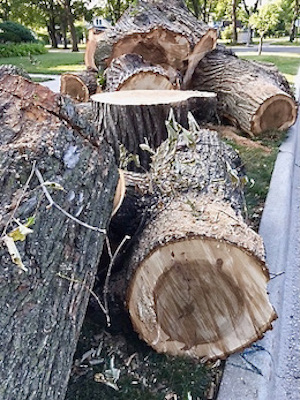Wouldn’t it be nice to have, as I call it, a wish list – wood? To have within reach all the wood you want, let alone even need? All the wood imaginable from anywhere in the world? I do have a wish list for wood but it’s not etched in stone (no pun). The opportunity to have all that I want would be nice. But, I lament that I will never have that good fortune in my lifetime. I’ll tell you why.
Before the axe falls
The impact of over-harvesting and environmental disturbances has changed how lumber and its by-products are sourced today.
Genuine mahogany is a clear example. The wood yields desirable qualities including water resistance, mold resistance, low warp and shrink properties, and beautiful finishes.
Since the 16th century, its use in the creation of highly prized furniture, homes, cabinetry, staircases, boats, decorative pillars and other structures made mahogany the object of excessive demand and exploitation. The species became nearly extinct.
All within CITES
Now mahogany is subject to worldwide protection by CITES (Convention on International Trade in Endangered Species of Wild Fauna and Flora) to ensure that it remains a viable source of lumber for future generations.
CITES identifies tree species that are in the most danger of extinction because of international trade. Some popular woods used by woodworkers have been placed on the list, often after a ramp up of demand and eventual overuse.
Before long, detailed restrictions were applied to the trees, lumber, by-products and even finished products of the particular species. The result has been zero availability and confusion in interpreting the rules.
Right now cocobolo, which was a hot and trendy wish list exotic wood used for woodworking projects only a few years ago, is on CITES. Madagascar ebony, Cuban mahogany, Brazilian mahogany, Japanese oak, Honduran rosewood, black pine from Nepal, and stinkwood are also among the wood species on the list.
Buyer better be aware
The important thing, now, is that you, I, nor the lumber yard can buy or transport listed wood unless it can be proven that its possession occurred before the entry date on CITES.
Today, knowledge of CITES and concern for the environment are important when sourcing wood. Generally, it is safe to purchase wood from established lumber yards. DNA analysis and genetic distribution maps research has grown so much that it has been used to obtain criminal convictions when “suspected” logs are traded.
This is frustrating for a woodworker when you see the wood or know where to get it. Now you have to take a few more steps to verify the species and the true source of the wood, like rosewood. Then the middleman buyer has to be verified.
This is significant because CITES also specifies that if the buyer suspects that the wood is not legal and did not verify the wood, then buyer along with supplier will be liable to criminal action.
Respect for traditional medicine
South African stinkwood or laurel wood, is highly prized by cabinet makers for its density and very fine finishing properties. Commercial logging, however, has resulted in the annihilation of the forests.
Additionally, the bark is fatally stripped from the tree by local communities in order to access the tree internally. The substances are then used to treat urinary diseases in traditional medicine. Local use does not cause near the level of damage as logging.
It is agreed, however, that the species must be preserved for future use by mankind.
I would love to work with rosewood, mahogany or even stinkwood. I can’t get them as long as these species are on CITES.
Trade restrictions must balance all uses. My hope is that the local use of stinkwood for medicinal purposes and the related knowledge accumulated by the local communities is respected and preserved as well.

Wish list wood for the future
A worldwide project to accelerate tree planting and preservation to help address the climate crisis, restore trees to the landscape, and benefit communities everywhere is among many addressing issues of shrinking viable world resources.
In the U.S, this means millions of trees will be planted on suitable land via reforestation, silvopasturing (grazing livestock in planted forests), and urban reforestation.
These steps will help store more carbon, thereby reducing heat effects on people, livestock habitat, water, and forest industries.
Half of all U.S. forests used for timber are considered understocked by the Forest Service. That fact is evident when I visit the lumber yard.
Increasingly, the yards are not well-stocked and the quality of lumber has deteriorated. If I do find a species of wood required for a project, it takes more time to select enough suitable pieces.
Sourcing project wood
If you don’t have a lumber yard close to you, go online. There are lumber suppliers who can arrange for you to pick up an order or have it shipped to you. I’ve done this a few times and had a great experience. Again, the vendor should have information about the wood and should be able to answer your questions.
The absence of a lumber yard nearby does not have to shut you down.

Numbers Do Lie
I wish I had a place to put a wood pile for future use in my projects. It seems that the supply of wood is younger and not as nice. Dimensioned wood has shrunk, too. For many years now, a two by four is not a 2″ x 4″ anymore. It’s a 1-1/2″ x 3-1/2″, but is still called a two by four.
Imagine that sinking feeling, as I had when repairing a fence, that something bad was happening. Now, greater care must be taken when doing repairs or replacement work on existing structures. “New” wood intermixed with older wood can make the work look a bit slipshod and, well, repaired.
And sometimes you have no choice but to eliminate the aesthetics and consider only the function. Bringing the situation back to the beginning, it’s just wood.
Wood wish list tempered by knowledge
The best response to the current scenario is to become a student of trees, lumber and wood. It will help in identifying a similar, more abundant species with the properties that fit your requirements.
Know what species are available near you. I have found walnut, cherry, maple, poplar, and pine at most lumber yards. Don’t ignore plywood. There are cabinet grade plywoods and bendable plywood. Glued up panels, and other options can be used to make anything depending on the purpose and the end user. Kicking conventional thinking aside, there are no limits.
I have used wonderful domestic and imported woods such as zebra wood, tiger wood, pecan, and purple heart. Staples such as aspen, hickory and ash are woods that I have adapted for a project or two.
Supplies of walnut, cherry, birch and beech can fluctuate. Sometimes the lumber you want is not currently available, thereby requiring a quick decision to take something else. For me, that is what makes woodworking fun. I learn about more abundant, sustainable woods I never would have considered. Yes, it’s the knowledge of the ages in your hands.
One thought to quell any worries if you do want “mahogany”: African mahogany and sapele are beautiful woods that carpenters and woodworkers use today as stand-ins for the genuine item.
Also, stains, paints, washes, tints and other substances can be mixed and blended to mimic woods. Ebonizing, fuming or simply weatherizing pieces will satisfy a requirement. Lastly, wood veneers offer alternatives that surpass expectations of solid wood.
All of this only touches the surface of workarounds and alternatives for materials that could be used for woodworking projects.
That Old Wood File

I introduced you to my wood sample file box of the wood used in all my projects. I document my experience with a particular wood from the initial first cut to the final finish with photos and notes. All of this helps in recalling names, characteristics, and lessons learned.
After the Storm
In the meantime, trees fallen after a storm and reclaimed wood from old barns have always been sources for wood used to make new projects. Old wood has already been milled or flattened and it’s seasoned and stronger. It can be a joy to work with.
Flea markets and antique markets have a ready supply of old furniture whose value may only be in the wood used to make it.
If you have your own stash of lumber, consider yourself lucky. If you are offered a long-time stash of mahogany, walnut, orange osage, basswood, or any other kind of wood, take it!
Gifted or inherited lumber is the envy of many woodworkers, including myself!
If you have access to a lumber yard that has a nice and varied inventory of lumber and lumber related products, consider yourself extra lucky.
Take advantage of your good fortune and visit the place. Get to know the people who work there. Ask for help when you need it and bring your gloves.
Going on my way with respect
On the path to self-awareness, my life as a woodworker is not without conflict or contradiction. In order to do this work of mine, trees must be cut down, logged, milled, and shipped. Then they are cut some more and transformed into that thing of utility or beauty we imagined in our mind or on paper. That is the one hand.
On the other hand, I am aware that in my simple demand for the material that I use in my small wood shop, I help perpetuate cruelty and mismanagement of earth’s natural resources. With each and every one of us in the mix, it adds up.
People, primitive or not, who live with the trees, who listen to the trees’ whispers, moans, screams, and pleas for rest are alerting us all.
Will we listen?
I look at trees, especially the really big old trees, and know I am in the presence of an earthly elder. One that is wise and all-knowing, strong yet fragile.
I’m using my knowledge and acquired wisdom to use only what I need and no more.
🟢
You know, that’s a hard thing to do.
Earth Day 2021
2050
-Shirley J
🥀

